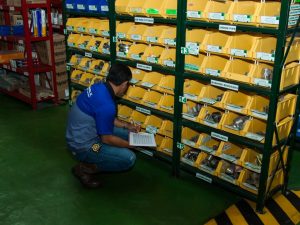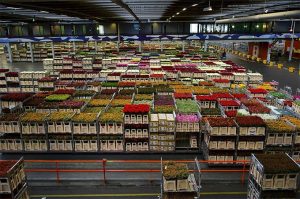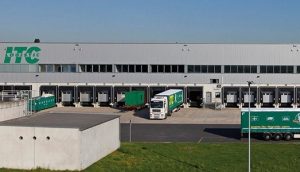Inventory appears in current asset in an organization’s balance sheet. It is a major activity of any business operation. For manufacturers, inventory includes raw materials, work in progress and finished goods. For resellers, it includes products acquired by him to resell to customers. Inventory management consists of the function of defining the size of inventory establishing procedure of effective inventory handling, maintaining control on inventory making efforts to reduce costs related to inventory. Every organization needs inventory for smooth running of its activities. The basic difference between a merchandising company and a manufacturing company is that a manufacturer creates products and a merchandiser sells them. Merchandisers include both wholesalers and retailers.
Good management of inventory usually ensures availability of materials in sufficient quantity as and when required and also helps to minimize investment in inventories. The efficiency of a firm to earn profits depends to a great extent on its ability to manage working capital because part of working capital is invested in the inventory. It involves many types of costs associated with it such as purchase cost, ordering cost, carrying cost, storage cost, service cost, risk cost, warehouse cost, pilferage cost, obsolescence cost etc. It is the only item of current assets which has direct influence on the prices and income of a firm.
To curtail losses in inventory, HUL implements risk mitigation strategies such as shorter response and planning cycles to deal with the high volatility in business operations related to input costs, demand trends, commodity prices, inflation and interest rates. HUL has rolled out a new go-to-market distribution model. This model reduces complexity at the front-end and enables efficiencies across one extended supply chain and consequently considerable reduction in cost. HUL is pumping in higher investments in advertising and promoting smaller brands, such as Rexona, Breeze or Hamam in soaps. It also dropped prices of brands like Wheel or Surf and restored rummage or product quantity across brands, such as Wheel and Lux, to take on the growing competition from more price competitive national and regional brands.
Generates Revenue: For any firm, inventory is the driving force because it has the ability to generate revenue and profits. Revenue is the money the firm receives at the time it sells inventory. Profit equals the final income after subtracting variable costs. This means the ability to get inventory at the lowest cost possible and sell it at the highest price is key to a successful, profitable operation.
If a firm orders too much inventory, it pays more money for employees to organize it and manage it. It also spends more for storage and handling expenses to hold it. It also holds risk on wastage on expired or pilferage of items. Simultaneously, having too little inventory can lead to stock-outs, which is bad for customer service.
Turnover: Turning over inventory efficiently is very important for firms. Calculating the inventory turnover ratio helps the firm to see how efficiently it sells through its inventory. The formula is costs of goods sold divided by average inventory level for a given period. A high turnover rate means the firm gets products off the shelf while they have maximum value to customers. Which also makes room for newer merchandise of products in demand. A lower turnover ratio leads to higher management costs and more waste. It also forces the firm to have more sales promotions to clear out excess products.
Just-in-Time: A common approach to inventory management in the latter 20th and early 21st centuries is just-in-time or JIT inventory. This is a technology-driven method which helps in keeping the inventory at ideal levels where a firm checks whether it has enough stock on hand to cover customer demand, but not too much to lead to high costs. Firms need to have strong relationship with key suppliers to integrate their inventory data through shared software databases. One of the key factor of JIT is that it allows automated ordering so that suppliers can quickly supply new material as needed by the firm. Most of the organizations have raw material inventory warehouses attached to the production facilities where raw materials, consumables and packing materials are stored and issued for production on JIT basis. The reasons for holding inventories can vary from case to case basis.
Good inventory management is advantageous in terms of price management: If a price rise is expected few months down the line due to changes in demand and supply in the national or international market, impact of taxes and budgets forces the firm’s pricing. Therefore, buying materials in advance and holding stocks helps firms as hedging against increased costs. Smart companies resort to buying in bulk and holding raw material inventories to take advantage of the quantity discounts offered by the supplier. In such cases the savings on account of the discount enjoyed would be substantially higher that of inventory carrying cost.
Safety stock reduces transit cost and transit times: In case of raw materials are being imported from a foreign country or from a far-off or distant vendor within the country, firms can save a lot in terms of transportation cost, buying in bulk and transporting as a container load or a full truck load. Part shipments often are costlier. In terms of transit time too, full container shipment or a full truck load is direct and faster unlike part shipment load where the freight forwarder waits for other loads to fill the container which can take several weeks. In terms of saving time due to shipping delays and transportation, which can further hamper the supply chain, holding safety stock of raw material inventories is always preferable.
ITC has invested in automated information technology (IT) systems and has lined up a number of initiatives in stock tracking and stock clearance more efficiently. With new businesses and diversification, ITC’s stock keeping units (SKUs) have increased by over 50 per cent in the last few years. To keep track of stocks, to bring down distribution costs and to ensure prompt stock clearance, the firm has invested substantially in IT and have lined up a number of new projects to ensure ease in operations. So far, all ITC products were bar coded at the retail level. But now, ITC has started bar-coding its products at the warehouse itself. This is expected to help ITC keep track of product manufacturing time, thereby enabling implementation of first-manufactured-first-out (FMFO) strategy, which means items manufactured first are shipped out of the factory and the warehouse earlier. This has been facilitated by the implementation of identification technologies and controlled batch management processes. The automation in IT systems helps ITC to keep track of date-of-manufacturing and details like weightage and the factory location that manufactured respective products. ITC has over 39 warehouses in India and uses close to 500-800 trucks per day for shipmen
Conclusion: Inventory management helps make a business more profitable by reducing the cost of goods sold and increasing the sales. It helps increase speed, accuracy, accountability and mobility in all the operations and processes within a business. Both small and large business can benefit from inventory management by boosting efficiency in the supply chain and reducing costs and waste.















































